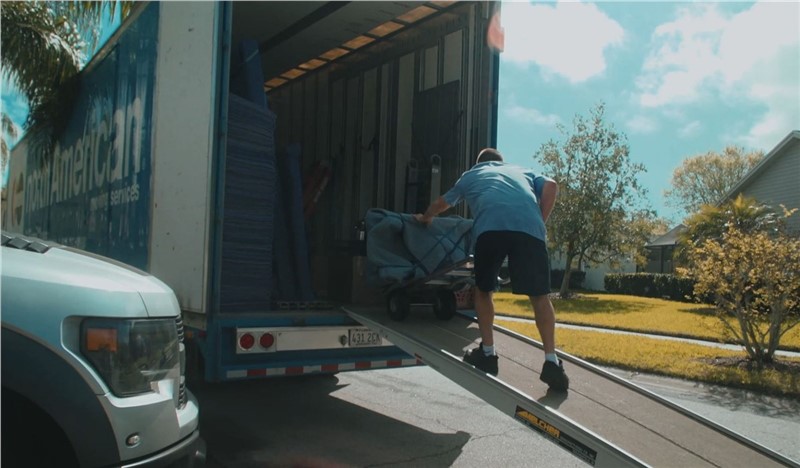Recognizing the Inclusions of moving and Freight Forwarding worldwide of Worldwide and residential Shipping
Steering through the complexities of moving and Freight forwarding can be challenging. Both procedures include distinctive procedures and requirements that are crucial for successful transport. Understanding the distinctions in logistics, paperwork, and threat administration is crucial for organizations and individuals alike. This expertise can substantially impact the effectiveness and safety and security of shipments. Many are not aware of the details components that affect the total experience and end results. What variables should one consider to guarantee a smooth transition?
The Basics of moving and Freight Forwarding
moving and Freight forwarding are fundamental elements of the global logistics market. They help with the transfer of products and individual belongings throughout worldwide and domestic borders. moving mostly entails the moving of people or families, including property and business needs. It typically includes packaging, packing, delivering, and unboxing things at the location. On the other hand, Freight forwarding is concentrated on the shipment of items, commonly in bulk, making use of numerous transportation settings, such as land.freight, sea, or air forwarders work as middlemans, collaborating logistics to guarantee prompt delivery while maneuvering via complicated regulations and customs treatments. Both procedures require mindful preparation, organization, and interaction to assure effectiveness and reduce disturbances. Comprehending these fundamentals is crucial for any individual associated with logistics, as they lay the foundation for even more sophisticated elements of shipping and transport management.
Secret Components of Freight Forwarding Solutions
Freight forwarding solutions incorporate a number of vital components that assure smooth transportation of items. Key responsibilities of Freight forwarders include taking care of logistics, collaborating deliveries, and dealing with custom-mades clearance. In addition, recognizing important delivery paperwork is crucial for compliance and reliable movement of cargo.
Freight Forwarder Responsibilities
A trusted Freight forwarder plays a crucial duty in collaborating the transport of items, making sure that shipments are taken care of effectively and in compliance with guidelines. Their duties include various vital jobs, including selecting excellent transportation routes, negotiating Freight rates, and taking care of logistics. They function as intermediaries in between carriers and carriers, making sure that freight is properly packaged and identified for risk-free transportation. Additionally, Freight forwarders track shipments, providing updates to customers about the status and expected shipment times. They likewise evaluate and handle risks related to transport, suggesting insurance choices as needed. By helping with interaction and documents, Freight forwarders simplify the delivery process, reducing possible hold-ups and enhancing total supply chain performance.
Delivering Documents Basics

Understanding Custom-mades Clearance and Documents
Exact documentation is important in the custom-mades clearance procedure, as it assures conformity with numerous regulations. A summary of custom-mades laws highlights the complexities dealt with by shippers and Freight forwarders. Usual clearance obstacles can greatly impact shipment timelines and expenses, making understanding this element important for effective logistics.
Value of Accurate Documents
Guiding via the complexities of worldwide shipping needs a keen understanding of customizeds clearance and the crucial duty of documents. Exact documents is vital for making certain that deliveries conform with laws and reach their locations immediately. Properly prepared papers, consisting of bills of lading, industrial invoices, and packing listings, assist in smooth interactions with customs authorities. Inaccuracies can lead to delivery delays, penalties, or even confiscation of goods. Comprehensive documentation help in tracking shipments and solving disputes. Businesses involved in moving and Freight forwarding must focus on thorough paperwork practices to navigate the detailed landscape of worldwide shipping effectively. This diligence not only improves operations but also boosts customer complete satisfaction by making sure timely shipment.
Customizeds Rules Review
Steering custom-mades regulations is an essential facet of international trade that directly influences the success of moving and Freight forwarding operations. Effective customizeds clearance calls for an understanding of various guidelines, consisting of tariffs, duties, and import/export constraints. Accurate documentation is essential, as it guarantees compliance with lawful requirements and helps with the efficient movement of products throughout borders. Trick papers commonly include commercial billings, packaging listings, and costs of lading, which provide in-depth information regarding the shipment. Furthermore, personalizeds brokers play a vital function in guiding intricate regulations, serving as intermediaries between shippers and customizeds authorities. By preserving extensive expertise of customs processes, companies can significantly lower delays and decrease prices connected with international shipping.
Common Clearance Challenges
Countless obstacles can occur during the customizeds clearance process, frequently making complex the movement of items throughout boundaries. One significant concern wants documentation, which can bring about hold-ups and charges. Merchants and importers should assure all required documents, such as billings, packaging checklists, and certifications of origin, is full and accurate. Furthermore, inconsistencies in appraisal can trigger Extra resources scrutiny from personalizeds authorities, leading to additional duties or assessments. Language barriers may likewise posture difficulties, as miscommunication can cause misconceptions relating to regulations. Modifications in customizeds policies can create confusion, demanding constant vigilance by carriers. Inevitably, getting rid of these clearance challenges needs extensive prep work and a clear understanding of custom-mades demands to assist in smooth worldwide transactions.
Packaging and Classifying Demands
Although often forgotten, product packaging and labeling needs storage companies play a necessary role in the shipping process, making sure that products are shielded and quickly recognizable throughout their trip. Correct product packaging safeguards products from damages throughout transit, while also assisting in reliable handling and storage space. Making use of ideal products, such as bubble cover, foam, or tough boxes, can stop breakage and loss.Labeling is equally essential. Precise and clear labels convey vital details, consisting of the location, handling instructions, and materials. Tags need to adhere to policies certain to domestic and global delivery, which may consist of harmful products identification or customs declarations.Moreover, standard labeling methods simplify the monitoring procedure and improve total logistics effectiveness. By adhering to product packaging and labeling needs, businesses lessen the risk of hold-ups, damage, or misdelivery. Inevitably, these methods contribute substantially to the success of moving and Freight forwarding procedures, guaranteeing a smooth shipping experience for all events involved
Tracking Deliveries: Relevance and Methods
Reliable packaging and labeling established the structure for successful delivery management, however tracking deliveries is equally vital in the delivery process. Shipment monitoring offers real-time visibility, which aids consumers and services monitor the development of their products. This transparency improves consumer fulfillment, considering that customers can remain educated concerning delivery timelines and any type of prospective delays.Several techniques help with effective tracking. Barcode scanning is a typical method, using distinct identifiers to monitor bundles throughout their trip. In addition, GPS technology allows precise location tracking, permitting timely updates and enhanced logistics management. Numerous shipping business now provide digital systems and mobile applications that offer individuals with very easy accessibility to tracking information.The importance of delivery monitoring can not be overemphasized; it lessens the danger of lost or damaged products, improves functional efficiency, and fosters trust between shippers and receivers. Incorporating reliable tracking approaches is important for successful domestic and international delivery operations.
Insurance policy Options for Your Item

Safeguarding insurance coverage for goods in transit is a vital factor to consider for people and businesses alike. Insurance coverage alternatives vary based on the kind of delivery, worth of items, and certain dangers involved. Usual types include copyright responsibility, which covers loss or damage while in transit, and full-value insurance policy, supplying extensive coverage for the total worth of the goods.Shippers might likewise take into consideration aquatic insurance policy for worldwide deliveries, safeguarding against dangers connected with sea transport. It is important to evaluate the specific needs of the delivery and evaluate the conditions of any policy.Furthermore, recognizing exclusions and restrictions is essential to click this site prevent possible voids in coverage. Shippers ought to involve with insurance policy experts to discover tailored services that fit their one-of-a-kind situations. Ultimately, investing in the best insurance coverage can reduce monetary dangers and give comfort during the delivery procedure.
Choosing the Right moving and Freight Forwarding Service
When choosing a moving and Freight forwarding solution, it is important for individuals and services to thoroughly assess their specific needs and concerns. Aspects such as the volume of goods, location, and timeline play a significant duty in this decision-making process. Looking into different carriers is a good idea; comparing their solutions, pricing, and client evaluations can expose useful insights.Additionally, it is essential to take into consideration the experience and knowledge of the service company in managing particular kinds of cargo, specifically for global deliveries that might involve customs clearance. Openness in prices, consisting of any covert costs, must likewise be scrutinized.Furthermore, examining the degree of client support provided is vital, as timely interaction can minimize issues during transit (shipping overseas). Lastly, verifying the schedule of insurance choices assures that goods are secured throughout the delivery procedure. By taking these steps, businesses and people can make informed options that align with their logistics requirements
Regularly Asked Concerns
What Sorts Of Product Can Be Shipped Worldwide?

How Do Delivery Expenses Vary Between Various Service Providers?
Delivering expenses differ significantly between service providers because of aspects such as service rate, freight type, range, and added services supplied. Each service provider's prices model mirrors these variables, affecting general delivery expenses for customers.
Can I Ship Hazardous Products or Perishables?
Shipping harmful products and perishables goes through rigorous guidelines. Providers commonly require specific product packaging, labeling, and paperwork. Carriers need to ensure conformity with worldwide and neighborhood regulations to avoid charges and ensure secure transport.
What Should I Do if My Shipment Is Delayed?
When encountered with a delivery delay, one should initially get in touch with the service provider for updates. After that, examine any alerts received, evaluate alternate solutions, and keep all events informed concerning the circumstance to decrease disruptions.
Exist Weight Boundary for Delivery Containers?
Weight limitations for shipping containers vary depending on elements like container size and shipping regulations. Commonly, standard containers have an optimum gross weight of around 30,000 to 32,000 kilos to assure safe transportation and handling. In comparison, Freight forwarding is concentrated on the delivery of items, often in bulk, making use of various transportation modes, such as land.freight, air, or sea forwarders act as middlemans, coordinating logistics to ensure timely delivery while maneuvering through facility policies and personalizeds procedures. Trick responsibilities of Freight forwarders include managing logistics, coordinating shipments, and managing custom-mades clearance. A reliable Freight forwarder plays an important role in coordinating the transport of items, making sure that deliveries are dealt with successfully and in conformity with regulations. Reliable packaging and labeling established the structure for successful shipment monitoring, however tracking shipments is equally essential in the delivery procedure. Lots of shipping business now use digital systems and mobile applications that offer customers with very easy access to tracking information.The significance of delivery tracking can not be overstated; it minimizes the risk of shed or harmed products, improves operational efficiency, and fosters trust fund between recipients and shippers.
Comments on “Labeling insights that overseas movers recommend for safe cargo delivery”